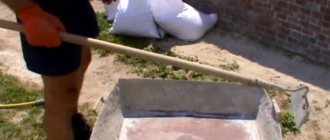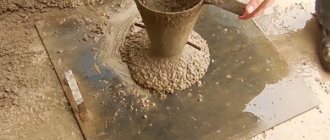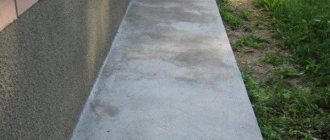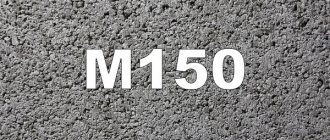Technical characteristics and properties of concrete
Concrete is formed by mixing two components: water and cement. This produces a hard cement stone.
Mixing the solution requires a thorough approach
For a stronger composition, the addition of special fillers is required. Gravel, sand and crushed stone allow you to create a material that seems to be reinforced with reinforcement. This has the effect of improving strength. In this case, the deformation property weakens. Without additional components, microcracks form in the cement composition.
The simplest manual kneading
Depending on the strength of concrete, it is divided into certain classes. The numerical value of the brand and the variety by class determines what type of construction a given material is suitable for.
The mixed solution is placed in a smaller container
The grade of concrete is determined at the design stage.
Concrete grades and areas of their application
Different brands of mixtures are used for certain types of buildings. Concrete consumption per 1 m3 of concrete depends on various factors. When choosing sand, it is necessary to take into account the composition of its impurities and particle size. For crushed stone, the density indicator and the content of foreign inclusions are important.
Mixture properties
The grade of concrete matters for the type of work for which the solution will be prepared. Various types are used for pouring foundations, erecting walls and for concrete screed.
Different jobs require a specific brand
For high-quality hardening, installation work must be carried out at positive temperatures. Within 12 hours after pouring, the solution hardens. After two weeks, the material gains most of its strength, and after a month the structure is completely ready for use.
Supply of ready solution
Helpful information! Work is not carried out at subzero temperatures, as the water in the mixture will freeze and the strength of the material will be lost.
Main components of concrete mortar
Using the table of concrete proportions per 1m3, you need to pay attention to the constituent components of the solution. Their qualitative characteristics matter:
- Cement should not have a long shelf life. The optimal indicator is less than four months. Bags of raw materials should not have hardened elements.
Cement packaging
- Only fresh water should be used.
The purest water is used
- The sand should not contain clay impurities. This mixture will have a yellowish color. It is better to use gray or white sand for the solution.
A certain type of sand is suitable for construction work
Related article:
How much does a cube of sand weigh? What types are there? How much does one cube weigh? How much can fit in the back of a KAMAZ? Read more in a separate publication on our portal.
- Crushed stone should not contain additional inclusions. The best option is to use crushed stone with granite content.
Crushed stone structure
Limestone or gravel can be used for concrete mortar. Granite is characterized by low water absorption and frost resistance. To improve some characteristics of concrete, special additives are added to the mixture:
- Plasticizers can increase the plasticity of the material. Hydraulic seals protect the structure from excess moisture.
- Dust removers can increase the strength of raw materials and reduce the risk of abrasion.
- Antifreeze additives allow the mixture to be used at low temperatures.
- Set retarders help regulate the drying time of the composition.
Special additives make the composition stronger
Material consumption: table of concrete proportions per 1 m3
The quality of the concrete used is influenced by the brand of cement and the purpose of the structure. The table of concrete proportions per 1m3 allows you to determine the required material consumption.
Proportions calculation table
To produce different grades of concrete, different quantities of components will be required. For example, you can calculate the composition of concrete m200 per 1 m3. For 10 buckets of cement you will need 35 buckets of sand, and 26 buckets of crushed stone. You will need 5 buckets of water. Knowing the density of each substance, you can calculate its weight in the bucket.
Calculation option in buckets
Video: ratio of concrete components M300
Features of preparing a solution for the foundation
When constructing small objects, it is worth calculating the material by buckets. This method is useful if the solution is used in small portions.
Calculation of proportions for a quality base
When determining the composition of concrete for the foundation, the proportions can be taken from the table below. In this case, concrete is selected for the foundation in buckets. The figures will vary depending on the brands used.
Pouring option for foundation
Important! The main strength of the foundation is given by filling in the form of crushed stone or gravel. You cannot use various types of river or sea pebbles, as they have a polished surface, which makes it difficult for the solution to adhere well.
Calculators for calculating the weight and volume of concrete ingredients for pouring a foundation
Concrete M200 (strength class B15)
Concrete M300 (strength class B22.5)
How many bags of cement are there in a cube of concrete?
Cement is sold in bags and therefore it is better to know how many bags of cement per 1 cubic meter of concrete will be required. There are also reference tables for this, but you can calculate it yourself. Counting is more accurate than using tables. Firstly, there are bags of 40 kg and 50 kg. This is a standard container. But there are also 25 kg and there are also a lot of such packaging. The table shows how many bags of cement are in the most popular brands of concrete.
How many bags of cement goes into 1 cubic meter of concrete?
In addition, it is rare that a whole number of bags are required per cubic meter. For example, M150 concrete requires 215 kg of PC400. Let's calculate the amount of binder in kilograms that will be needed to make 4.6 cubic meters of concrete. 4.6 m³ * 215 kg = 989 kg. Now we calculate the number of bags of cement that will need to be purchased:
- 25 kg each - 898 kg / 25 kg = 35.92 pcs. That is, you will need 36 pieces of 25 kg each;
- in 40 kg packaging: 898 kg / 40 kg = 22.45 pieces, rounded up, it turns out that you will need to buy 23 forty kilogram bags;
- 50 kg each - 898 kg / 50 kg = 17.96 pcs; You need 18 bags of 50 kg each.
Now let’s calculate how many bags of cement are needed per 1 m³ of concrete using the second table. Let's take the same example - 4.6 cubic meters of M150 concrete from M400 cement. According to the table, one cubic meter requires 4.3 bags of 50 kg and 5.4 pieces of 40 kg. Total, the entire volume will go:
- 40kg bags: 4.6 cubes * 5.4 pcs = 24.84 pcs or 25 bags.
- in 50 kg packaging: 4.6 cubes * 4.3 pcs = 19.78 pcs or 20 pcs.
The consumption of cement per cube of concrete is not that high, but the proportions must be strictly observed.
The table does not indicate the number of 25 kilogram bags. You can calculate it yourself - you need to divide the number of 50 kg bags by 2.
Stages of preparing the solution
Once the consumption of materials per 1 m3 of concrete has been determined, you can begin the main work. In individual construction, the concrete mixture is made from components that are measured in buckets.
Preparation of the solution manually
When measuring the required amount, you should take care of the dryness of the shovel and bucket for the dry mixture. To get more accurate proportions, the sand or crushed stone in the bucket needs to be pressed down a little and made denser along the edge of the container. It is recommended to mix the measured components in a large container. At the same time, small depressions are made in the mixture, into which measured cement is also poured. The table will help determine the quantity of all components, as well as the weight of concrete per 1m3. All components are thoroughly mixed until a homogeneous mass is obtained. Then, in the resulting mixture, you need to make a hole in the form of a cone and pour water into it. The mixture flows from the edges to the middle. In this case, the water is gradually absorbed. After the first portion of liquid has dissolved, additional water is poured in. This is done until the solution reaches the required consistency.
Preparation in a concrete mixer
Mixing the solution in a concrete mixer consists of the following steps:
- The calculated amount of water is poured. About 10% is left to be added later.
- Cement is added.
- Sand is falling. Mixing is carried out for several minutes.
- Additives are added: reinforcing mixtures or plasticizers.
- A filler of crushed stone or gravel is poured.
Features of foundation installation
If it is necessary to add water, a small amount of cement and water is mixed separately and then added to the main mixture. Mixing in a concrete mixer lasts no longer than 20 minutes so that the mixture does not set inside the equipment.
Mixture preparation options
Helpful information! Experts do not recommend making a solution that is too liquid. In this case, voids may form in the material, which will greatly affect the strength indicator.
M300
The M300 brand today has become one of the most popular when solving certain construction problems. This building material is used when there is a need to lay the foundation of buildings, fences, flights of stairs, piles.
Compound
For the convenience of preparing M300, a proportion of components has been developed, through the use of which you can use the necessary ingredients in the most accurate ratio. Concrete contains the following ingredients:
- cement;
- sand;
- crushed stone;
- water.
Return to contents
Proportions per m3
The table below shows how many components are required per m3.
Table 1.
If you need to get high-quality building materials, then it is better that the sand fraction is one and a half to three millimeters. In this case, it is important to use a homogeneous building material, without clay particles. Builders recommend adding river water because it contains no impurities.
Before using quarry material, it should be washed. The size of the crushed stone should be five to twenty millimeters. In such cases, professionals add granite crushed stone to the concrete.
Useful tips
Some tips from experts will help you increase the efficiency of working with the material:
- If the filling is of poor quality, voids will appear inside the composition, which can only be removed with special equipment.
- For small structures, grade 100 products are suitable.
- When creating a strip foundation, it is recommended to use grade 200 composition.
- It is impossible to erect a strip foundation during periods of cold weather. If the liquid freezes inside the concrete, the volume will increase and the structure will collapse.
- When pouring the foundation in the summer, within a few days after installation, it should be sprayed with water. As a result, the structure will not crack and will adhere evenly over the entire surface.
Features of the construction of a strip foundation
To ensure uniform drying of the concrete structure, it should be covered with film. This will prevent the outer layer from drying out quickly, and the composition will harden more evenly. Drying time depends on the thickness of the concrete layer.
The correct proportions allow you to create a high-quality mixture
Using a table of proportions for using concrete, you can create a high-quality and homogeneous solution. This will guarantee the durability and strength of concrete structures. Compliance with technical standards in the manufacture of building mixtures is important.
Price
For those who do not want to make this material themselves, you can purchase a ready-to-use mixture. Its price per cube will be 3,450 rubles.
Concrete M300 can often be found on construction sites. And this is not surprising, because the presented material is characterized by optimal performance characteristics and cost. M300 concrete can be purchased ready-made and you can be sure that all proportions have been met exactly, or you can make it yourself, as a result of which you will lose your time and effort.
Application
In construction, this material is used at every step. Not only walls are made from it, but also load-bearing beams. Where increased strength is required, reinforced concrete is used, which has metal pins inside to increase strength.
This material has many applications:
- during the construction of buildings and structures;
- performing repair work;
- military industry;
- use for design purposes;
- use in the mining industry;
- construction of facilities in the oil and gas industries.
The specific properties of concrete depend on how it was made by the manufacturer or prepared independently.
Concrete is actively used in various sectors of the economy.
*Explanations for the calculator
- The calculator can calculate the volume for both whole numbers and fractions. Example: concrete volume 3m3, concrete volume 50l (0.05m3).
- The calculator implements calculations for a mixture with mobility P3 (9-10 cm of cone slump) for cement-lime mortars (according to SP82-101-98). Water consumption for mixtures with different mobility is based on experimental batches. The mobility you need can be viewed in the “Mobility” field, which is automatically filled in when you select “Solution purpose”.











